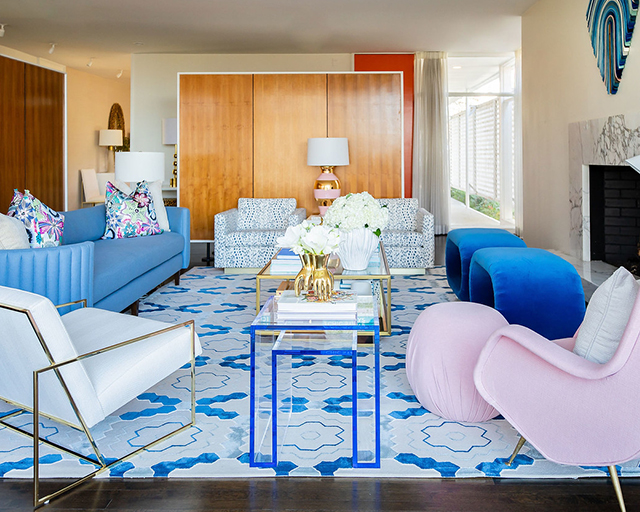How to Create a Beautiful Room From the Floor Up
 Interior design by House of Nomad. Photography courtesy of House of Nomad.
Interior design by House of Nomad. Photography courtesy of House of Nomad.
While every design element in a room has a role to play, a rug can serve as the cornerstone, influencing everything from the color palette to the use of additional patterns and more. For advice on how to create a beautiful and functional foundation with rugs, we reached out to four experts across the country for recommendations on how to cohesively incorporate these essential pieces into your decor. Here, they share tips and tricks for selecting the perfect piece to anchor—and inspire—any space. Find a rug expert in your area in The Scout Guide Directory.
Work your way up. While different elements can serve as the inspiration behind a room, building a design off of a rug selection is a wonderful place to start, advises Parisa Abdollahi, owner of Parisa Rugs and Decor in Old City, Philadelphia, Pennsylvania. “Seasoned designers often start with the rug, and let the colors, scale, and pattern direct all of their decisions, from furniture to wallpaper,” she says.
 Interior design by Beckley Design Studio. Photography courtesy of Beckley Design Studio.
Interior design by Beckley Design Studio. Photography courtesy of Beckley Design Studio.
Consider color. Echoing Abdollahi’s point above, Kelly Roberts, principal at Beckley Design Studio in Fort Worth, Texas, says that if she finds a lovely antique rug with multiple colors, she will often design the room around it. “We would typically select two colors from the rug to accent with and keep the rest neutral,” she notes. Single-color rugs can pose a challenge, however, according to Anna Grace Augusto, owner of Augusto Fine Rugs in Boise, Idaho. When designing a room, very seldom does she opt for a solid-colored rug because it is often too visually heavy. “When a client is requesting a solid rug, I interpret that they are really looking for a rug with a design that is quiet and does not have a lot of color contrast,” she explains.
Know that size and scale are key. “Size and scale are the biggest mistakes people make with rug selection,” Kelley Lentini and Berkeley Minkhorst, co-founders of House of Nomad in Charlotte, North Carolina, say, noting that rugs should fill the area you are designing and anchor the furniture. For example, in a dining room, you want to ensure your chairs fit all the way onto the rug. In a living room, the rug should be placed completely (or almost completely!) underneath all furniture, and in a hallway or entryway, the rug should fill the space nicely and not feel dwarfed.
Take pattern into account. “We will always advocate for pattern in a rug because it makes such an impact—and can easily be changed out at a later time if the client needs a new look,” Roberts says. Still, “We don’t want the rug to compete with the room or be too distracting,” she asserts. If you choose to go with something bold, ensure that the surrounding upholstered pieces are solid with the exception of a smaller pattern in accompanying chairs or throw pillows. If the upholstered pieces are patterned, sometimes it’s best to keep the rug solid or neutral.
 Interior design by House of Nomad. Photography courtesy of House of Nomad.
Interior design by House of Nomad. Photography courtesy of House of Nomad.
Play with texture and layers. If you’re considering a solid rug, Augusto likes to opt for ones with a bit of texture. “It’s a good way to add dimension to the color, and the texture of the weave becomes the ‘pattern,’” she says. Lentini and Minkhorst love to ground a great room in a jute or sisal rug, as it does the job of filling the space and defining the area, but since natural rugs are not very soft underfoot, they often layer a plush Moroccan or vintage Turkish rug on top to cozy up the space. “Sisal and wool textures are very complementary,” they note.
Remember that trends come and go. Area rugs can be quite an investment, and for this reason Augusto always encourages her clients to purchase what they are naturally drawn to rather than something that feels of-the-moment. “There are other areas in a room where you can insert more fashion- focused items, yet an area rug should be able to span the test of time,” she says. “I have found if a client truly loved their rug when they selected it, chances are they will love it for years to come. With the area rug as the anchor for the project, the ability to shift other items in the room allows the design to be more fluid.”
Leave no surface untouched. There are innumerable places you can use a floor covering, from placing a runner in a bathroom to adding softness with a rug in a laundry room, kitchen, and hallway. Taking a cue from her Iranian heritage, Abdollahi likes to take her vintage Persian rugs outside. “In Iran, people are known for outdoor picnicking and gathering and often use their rugs as an outdoor mat,” she says. “Persian rugs are meant to be gardens on the floor. With floral and animal motifs, they are a celebration of nature all around. It makes perfect sense for them to be used outside.”
TSG Tip 406 from Parisa Abdollahi, owner of Parisa Rugs and Decor in Philadelphia, Pennsylvania; Kelly Roberts, principal at Beckley Design Studio in Fort Worth, Texas; Anna Grace Augusto, owner of Augusto Fine Rugs in Boise, Idaho; and Kelley Lentini and Berkeley Minkhorst, co-founders of House of Nomad in Charlotte, North Carolina. Parisa Rugs and Decor appears in The Scout Guide Main Line & Philadelphia. Beckley Design Studio appears in The Scout Guide Fort Worth. Augusto Fine Rugs appears in The Scout Guide Boise. House of Nomad appears in The Scout Guide Charlotte.




